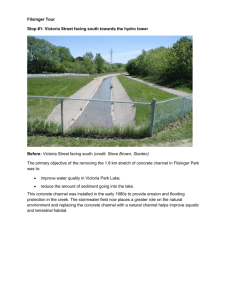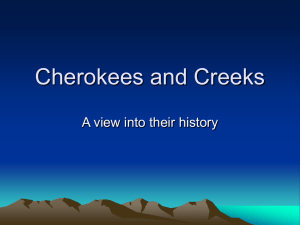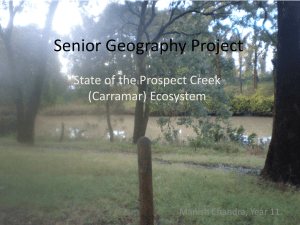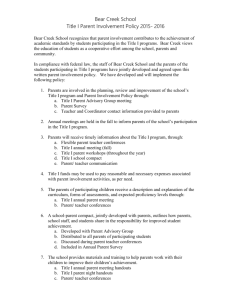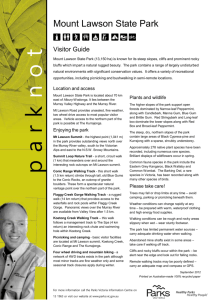Broken-Boosey State Park
advertisement
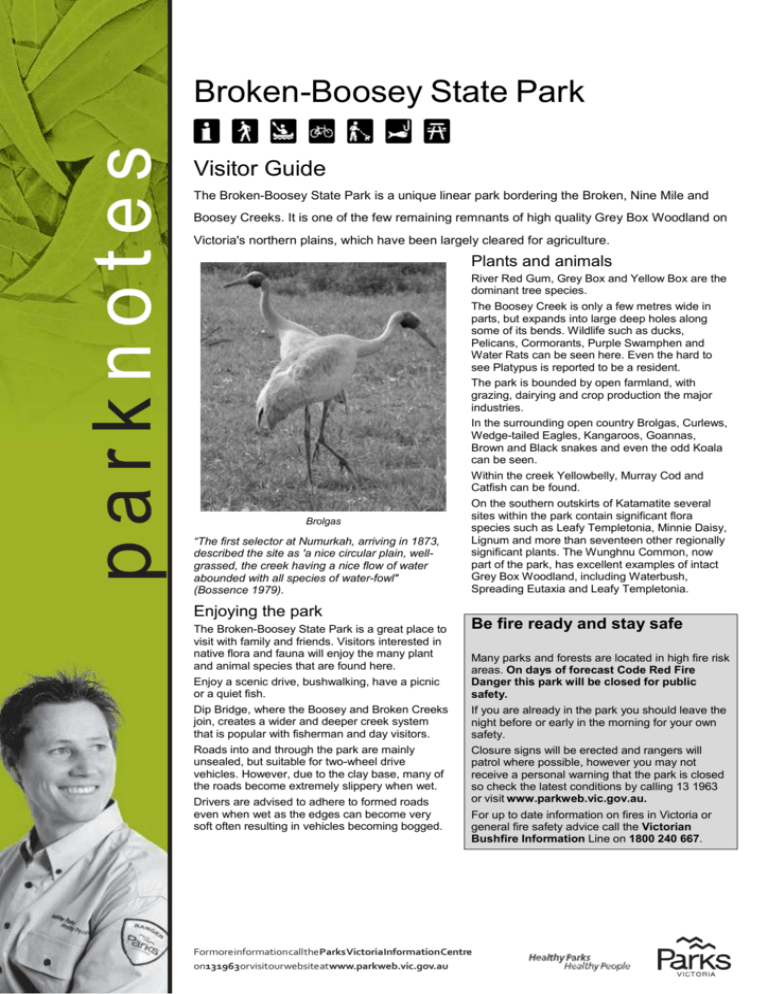
parknotes Broken-Boosey State Park Visitor Guide The Broken-Boosey State Park is a unique linear park bordering the Broken, Nine Mile and Boosey Creeks. It is one of the few remaining remnants of high quality Grey Box Woodland on Victoria's northern plains, which have been largely cleared for agriculture. Plants and animals Brolgas “The first selector at Numurkah, arriving in 1873, described the site as 'a nice circular plain, wellgrassed, the creek having a nice flow of water abounded with all species of water-fowl" (Bossence 1979). Enjoying the park The Broken-Boosey State Park is a great place to visit with family and friends. Visitors interested in native flora and fauna will enjoy the many plant and animal species that are found here. Enjoy a scenic drive, bushwalking, have a picnic or a quiet fish. Dip Bridge, where the Boosey and Broken Creeks join, creates a wider and deeper creek system that is popular with fisherman and day visitors. Roads into and through the park are mainly unsealed, but suitable for two-wheel drive vehicles. However, due to the clay base, many of the roads become extremely slippery when wet. Drivers are advised to adhere to formed roads even when wet as the edges can become very soft often resulting in vehicles becoming bogged. River Red Gum, Grey Box and Yellow Box are the dominant tree species. The Boosey Creek is only a few metres wide in parts, but expands into large deep holes along some of its bends. Wildlife such as ducks, Pelicans, Cormorants, Purple Swamphen and Water Rats can be seen here. Even the hard to see Platypus is reported to be a resident. The park is bounded by open farmland, with grazing, dairying and crop production the major industries. In the surrounding open country Brolgas, Curlews, Wedge-tailed Eagles, Kangaroos, Goannas, Brown and Black snakes and even the odd Koala can be seen. Within the creek Yellowbelly, Murray Cod and Catfish can be found. On the southern outskirts of Katamatite several sites within the park contain significant flora species such as Leafy Templetonia, Minnie Daisy, Lignum and more than seventeen other regionally significant plants. The Wunghnu Common, now part of the park, has excellent examples of intact Grey Box Woodland, including Waterbush, Spreading Eutaxia and Leafy Templetonia. Be fire ready and stay safe Many parks and forests are located in high fire risk areas. On days of forecast Code Red Fire Danger this park will be closed for public safety. If you are already in the park you should leave the night before or early in the morning for your own safety. Closure signs will be erected and rangers will patrol where possible, however you may not receive a personal warning that the park is closed so check the latest conditions by calling 13 1963 or visit www.parkweb.vic.gov.au. For up to date information on fires in Victoria or general fire safety advice call the Victorian Bushfire Information Line on 1800 240 667. Formoreinformation call theParks VictoriaInformationCentre on131963orvisitourwebsiteatwww.parkweb.vic.gov.au For further information Parks Victoria Information Centre Call 13 1963 or visit the Parks Victoria website www.parkweb.vic.gov.au Greater Shepparton Visitor Information Centre 534 Wyndham Street Shepparton 3632 Freecall: 1800 808 839 Echuca-Moama Visitor Information Centre 2 Heygarth Street Echuca 3564 Freecall: 1800 804 446 Caring for the environment Help us look after your park by following these guidelines: Please take rubbish away with you for recycling and disposal All native plants and animals are protected by law. Please do not disturb them Dogs are permitted on formed roads and tracks in the park, and must be kept on a leash Firearms are prohibited Fires are not permitted in the park, however gas barbecues can be used. No fires, including gas barbecues, may be lit on a day of Total Fire Ban. Broken-Boosey State Park is in the North East Total Fire Ban District It is your responsibility to know if it is a day of Total Fire Ban. If in doubt call the Victorian Bushfire Information Line on 1800 240 667 Park closures - Be prepared to leave early as extreme weather may cause the closure of some park areas for public safety Collection of firewood is prohibited from the park Be self-sufficient with drinking water. Carry it in and/or know how to make untreated water safe for drinking History There are many reminders of past Indigenous inhabitants within the park. Cultural surveys to date have recorded numerous Indigenous sites including canoe, shield and coolamon scarred trees along the entire creek line suggesting the creek was used as a pathway on a regular basis by the Yorta Yorta and Bangerang people. The creek was also an important source of food and drinking water. In 1848, Hamilton Hume settled the Yarrawonga run comprising 85,000 acres including the area now known as Tungamah. By 1850, squatting runs spanned the entire creek system and more than 60,000 sheep and 4,500 cattle grazed along the creeks. The natural creek lines were altered with the construction of weirs, channels and levees. The Tungamah Stock and Domestic | Water Supply System has been operating for over 100 years. This was recently replaced with a piped system that will return the creek back to natural flows. With the establishment of agriculture, many large trees were cleared for fencing and firewood. The Broken-Boosey State Park was proclaimed, along with several other new Victorian parks, in 2002 to conserve and enhance what remains of the Box-Ironbark forests and woodlands of northern Victoria. Nearby parks to visit There are many swamps in the area with a wide variety of birds and wildlife. Kinnairds Wetland, near Numurkah, has bird hides, signed walks, picnic shelters and carparking. Barmah National Park, situated on the Murray River flood plain north of Nathalia, comprises the largest River Red Gum forest in Victoria. The complex ecology of the forest is closely linked to the Murray River and its flooding regime, creating a diverse natural habitat for a variety of wildlife, particularly waterbirds. Warby-Ovens National Park - Extending north from the town of Glenrowan is a steep scarped range known locally as the Warbys. The combination of excellent viewing points along the ridge, pleasant picnic spots and an outstanding variety of birdlife and wildflowers makes a visit well worthwhile. Reef Hills State Park is an area of 2013ha of mixed eucalypt forest near Benalla. The forest is an important remnant of the original vegetation of the northern plains of Victoria and is valued by naturalists for its wide range of plant and animal life. Conservation Management Network While the park and the nearby Natural Features Reserves at Tungamah, Nathalia and Numurkah contain much of the high quality vegetation in the region, a significant amount of this vegetation is on private land. The Conservation Management Network provides an avenue for private landowners and government agencies to work in partnership to manage the environment. The Network provides communication links between managers of remnant vegetation. This linking enables the sharing of management knowledge and co-ordinated actions, works and funding. The Network helps improve and protect the important values of some highly fragmented conservation areas. It focuses on protecting ecosystems and threatened species across both private and public land. Membership is open to all people with an interest in Conservation Management. Contact the Department of Sustainability and Environment's Customer Service Centre on 136 186 for more information on how you can be involved. Facilities Motel, bed and breakfast, camping and caravan park accommodation is available in nearby towns. There are great camping options in the nearby Natural Feature Reserves at Tungamah, Nathalia and Numurkah,and Youarang. How to get there Broken-Boosey State Park is approximately 240km north-east of Melbourne along the Goulburn Valley Highway, past Shepparton on the Benalla-Tocumwal Road. Some roads may be subject to seasonal closure. Vehicles, including motor bikes, may only be used on formed open roads. Drivers must be licensed and vehicles registered and roadworthy. Healthy Parks Healthy People Visiting a park can improve your health, mind, body and soul. So, with over four million hectares of parkland available to Victorians, why not escape to a park today! December 2010 Printed on Australian-made, 100% recycled paper




